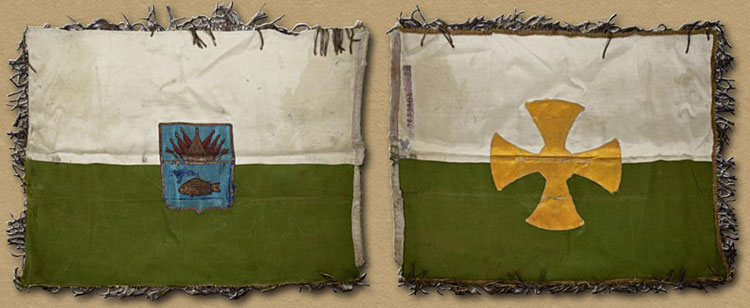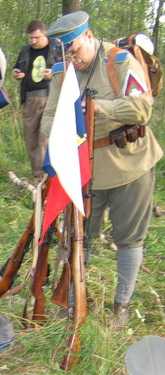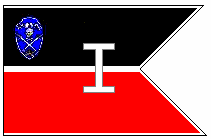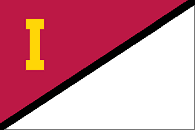
Flags of the Whites in the Russian Civil War
Did they even take flags into battle during the Russian Civil War?
Williamson, who was an eye-witness, relates:
"The artillery opened the attack and the colours were unfurled. The men were drawn up in battle array to the sound of music; bugles rang out, and the standards floated above the breeze. Swords flashed and a cheer went up, and the men moved forward in a cloud of dust."
"... we could just make them out pouring forward, waving flags and sweeping towards the Red positions in a swarm."
"... in a carriage drawn by two fast trotting ponies, side by side with the Russian [artillery] commander, whose flag – of colossal proportions! – floated from a pole on the box seat."
"... then the Cossacks were sweeping past, swinging round the rear of the Red cavalry, and the Reds began to throw in their hands before the two formations were properly locked together. Flags were thrown down and weapons followed."
Mamontov has a slightly different take, because he served as a courier for a while:
"Each regiment and divisional HQ had its insignia, and in the basically flat steppes of the northern Caucasus, they could be distinguished from far away. That greatly aided the work of the dispatch riders. It was only necessary to glance around to find the unit you were searching for."
These, and plenty of others, confirm that flags were commonplace in the front lines of the Civil War.
As with most things, the Whites carried over Imperial traditions in a large way. It is therefore quite useful to understand the old Imperial practice for flags when looking at the Civil War period.
Ceremonial Flags
When Imperial units were "reformed" they had a traditional flag to use, and in many cases the originals were smuggled out of Soviet territory. However many of the most elite units of the White armies were new formations, with no traditions to fall back on. Solutions varied.
- The Kornilov Horse were presented an old flag of a Black Sea regiment, in recognition of the fact that most of its men were Black Sea Cossacks.
- In 1920 Wrangel presented parade new flags to the key coloured regiments of his army. They resemble the old Nikolais in pattern, but differ by having a different slogan, the unit's cipher instead of the Tsar's and Nicholas the Wonderworker as the saint.
- It seems out in Siberia that Kolchak may have done the same, presenting units like the Votinski and Izhevski with elaborate banners, and some banners associated with Siberian units have Imperial patterns but a home-made look.
These remained parade flags though. Many were taken out of the country to prevent them falling into Bolshevik hands. As the White cause collapsed others were destroyed or buried to prevent their capture.
Divisional and Higher Flags
Orange and black striped flags (the colours of St George) had originally been used by Army commanders, and this was also revived in the Civil War.
- Kolchak, as Commander-in-Chief, for at least some of the time flew the old Imperial Army commander flag.
- Apparently Wrangel while a divisional commander had a small divisional flag in St George colours that followed him into action. He retained this when he moved to command the Caucasian Army.
- Ataman Annenkov's black hussars are shown with a striped flag behind them, suitable for his "Detached Army".
The Kornilov Division had an HQ flag in red and black, with a white border and a stylised KK in the centre.
Regimental Flags
Some repeated patterns can be seen from those flags either remaining from the Civil War, photographed or described fully.
Flags on the Imperial Patterns
The diamond pattern in a rectangle would have been easy to make in the difficult conditions of the Civil War, and lots of units flew them. Some of those include:
- The 9th Don Cossack Regiment had a flag with a red diamond inside a blue rectangle and the black monogram 9 Д К П, which is straight out of the old Imperial regulations for a regimental staff flag.
- The Kuban 1st Labinsk Cossack Regiment had a diamond in rectangle, but not to Tsarist colours, being black diamond inside red, with white lettering.
- The 6th Siberian Regiment had a dark red diamond on white, with the letters 6 С П.
- The 2nd Drozdovsky Infantry Regiment used a yellow monogram Д inside a raspberry diamond on white.
- The 2nd Drozdovsky Cavalry appears to have used a similar diamond, but where the diamond did not reach the borders of the white flag.
- The Alekseev Infantry Regiment and Cavalry Regiment had diamonds with an "A" made from swords and laurel branches.
Cossack Command Flags on the Imperial Patterns
Cossacks were traditionalists and mostly retained their Imperial regiments, so it would make sense they kept Imperial era flags.
- The 1st Siberian Cossack Regiment had a square red flag with white diagonal cross and the white lettering 1й Сиб. каз. полкъ, which is again pretty much straight out of Imperial regulations for a regimental commander's flag.
- The 11th Orenburg Cossack Regiment had a white saltire on blue, which was the Imperial pattern, but as a rectangle with white border and the name written out in abbreviated form in the spaces.
- The Kornilov Horse took a square red flag and added a black stripe and Kornilov's name, which is a variant on the square red flag which was regulation for a Kuban regiment .
Russian Tricolours
Many units flew the white, blue and red of the Russian flag with unit names and slogans added. This is probably the safest option when guessing flags for wargames units. Cossack units might do the same thing, but on their Host's flag instead of the national one: there are examples of Don units doing this.
- A tricolour can be seen in Moscow with writing for the 3rd Trans-Katun' [something] Regiment and an anti-Communist slogan.
- A photo of the 13th Belozersk Regiment in Kharkov in 1919 shows a tricolour with its name written on the front in large black letters in the top white section (and signs of further writing in the red and blue parts too, though its unclear).
- There is mention of a tricolour with Отечество (Fatherland) on it during the Kuban Ice March.
- The Markov Division used a Russian tricolour, with a black canton with white saltire cross in the top left corner.
- The Libau Regiment in Iudenich's NW Army used a tricolour with the addition of the unit's cipher inside a white cross.
- The 1st General Alekseev Cavalry Regiment of the Volunteer Army had a flag half tricolour-half their cipher (an elaborate A).

St George Flags
The orange and black stripes of St George were also a common background for flags when the unit had an association.
- The St George medal holder unit of V.O. Kappel in the early days at KOMUCH had an orange-black flag.
- The 23rd St George Gundorovski Infantry Regiment of the Don Host, had a banner of orange and black stripes with standard Tsarist picture of St George inside white cross on one side.
- One side of the flag of the St George Battalion of the Kornilov Regiment was an eagle and slogan in gold on a striped St George flag. (The other side was a representation of the ST George Medal in the middle on red, with SG cipher in yellow in the corners.)
St Andrews Flags
The Imperial navy had flown a St Andrews flag (diagonal blue cross on white) and this pattern appears several times in White units.
- The 1st Drozdovskiy Infantry Regiment used a diagonal blue cross on white, from when they merged with a Baltic marine unit.
- The Markov 1st Regiment used a white diagonal cross on black and the 3rd Markov Regiment the same but with a white border to difference it.
- Several Cossack units had St Andrews crosses, with abbreviations of their names in the spaces around.
Imperial Eagles
Particularly with units formerly of the guard. Traditionally guard units had flags with a yellow background colour.
- Budënniy mentions Don "officer" units with eagles on black backgrounds in The Path of Valour.
Maltese Crosses
This was the form of many Imperial Russian medals, and had been a design on many Imperial flags, especially with St George in the middle of the cross.
- The Markov 2nd Regiment had a white outline Maltese cross on black.
Skull and Bones
This was associated with "Shock" units, along with red and black colours.
- The Kornilovs had such a flag from the start of the war through to the Crimea, and it may have remained the 1st Kornilov Regiment's battle flag.
Siberian Colours
 This is the banner of the 16th Ishim Regiment. The shield in blue is the coat of arms of Ishim.
This is the banner of the 16th Ishim Regiment. The shield in blue is the coat of arms of Ishim.
It seems a few units of the Siberian Army used the white over green of Siberia, with a gold rounded militia cross on one side and the coat of arms for their place of formation on the other.
Not all Kolchak's units were in the Siberian Army, but this system can be used to generate suitable flags for many of his men.
Battalion and Company Flags
The Kornilov Regiment of the AFSR appears to have used battalion flags on bayonets. In the Army Museum in Moscow one can be seen behind the manequin in the Kornilov uniform. (Small flags also appear behind the Markov and Drozdovsky models, but as they hang vertically they may be different.)


It would seem likely that any old Imperial unit would use the former Imperial system for battalion flags, likely switching to white-blue-red from the Tsarist white-orange-black though. The re-enactors to the right (Lieven's Regiment, NW Army) seem to think so. This is what they use:

Evidence of White company and squadron level flags is slim, although they can be seen in some photos of the period. Many many White battalions were only company sized in any case, so company flags would not have been necessary for many.
Seen with the Drozdovskiy re-enactors at www.anticom.ru is this company or battalion level flag:

Squadron Flags
It seems likely that reformed Cossack Regiments would have used their old sotnia system – if they went to the bother of reviving old units it would seem odd to then change such details. The reformed "composite" imperial regiments in the AFSR and Russian Army had squadrons trying to keep their old traditions, and using the previous regimental colours would be a fairly obvious way of doing this.
- The Kornilov Horse Regiment carried sotnia banners in the old Kuban style, but with a difference of a black diagonal.
- Shkuro's Wolves carried sotnia banners in a standard pattern.
- White Guard #8 shows a set of sotnia style flags for the units of the Don "Steppe March" although some seem rather dodgy. As ad hoc units they had no historical banners, but the carry over of themes is fairly obvious.
Battery Flags
We know they flew them, as Williamson and Mamontov note them, but they were likely made to personal taste.
- We know the 2nd Drozdovsky Battery (Mamontov's) flew a black-red-black guidon.
- Apparently the 1st Markov Battery flew what was effectively their shoulderboard cipher – a gold curlicue "ГМ" and crossed cannons on black.
Conclusion
We can assume that the flags that have survived the Civil War have a tendency to be the most symbolic and precious. Many are probably only ceremonial and few come from a level below regiment. Therefore it seems reasonable that the ordinary battle banners were less ornate on average, than those remaining in museums and shown on web-sites.
Working from what we do have surviving the Civil War, we see few were entirely novel in their style, and many units used the old style flags or amended them only slightly by a unit cipher.
Those that were most different tended to belong to new units, rather than units seeing themselves as reformations of old units. Even then the themes tend to be old Imperial ones: national colours, St Andrews cross, St George stripes and badges, Imperial eagles, rounded and square Maltese crosses (the form of the Tsarist medals) and religious pictures (especially the Christ's head as appeared on the Nikolais). Many new units carried their shoulderboard cipher across to the flag.
One unusual, but common, feature is that flags often did not carry the same pattern on the front and reverse. Even the base colour might be different.